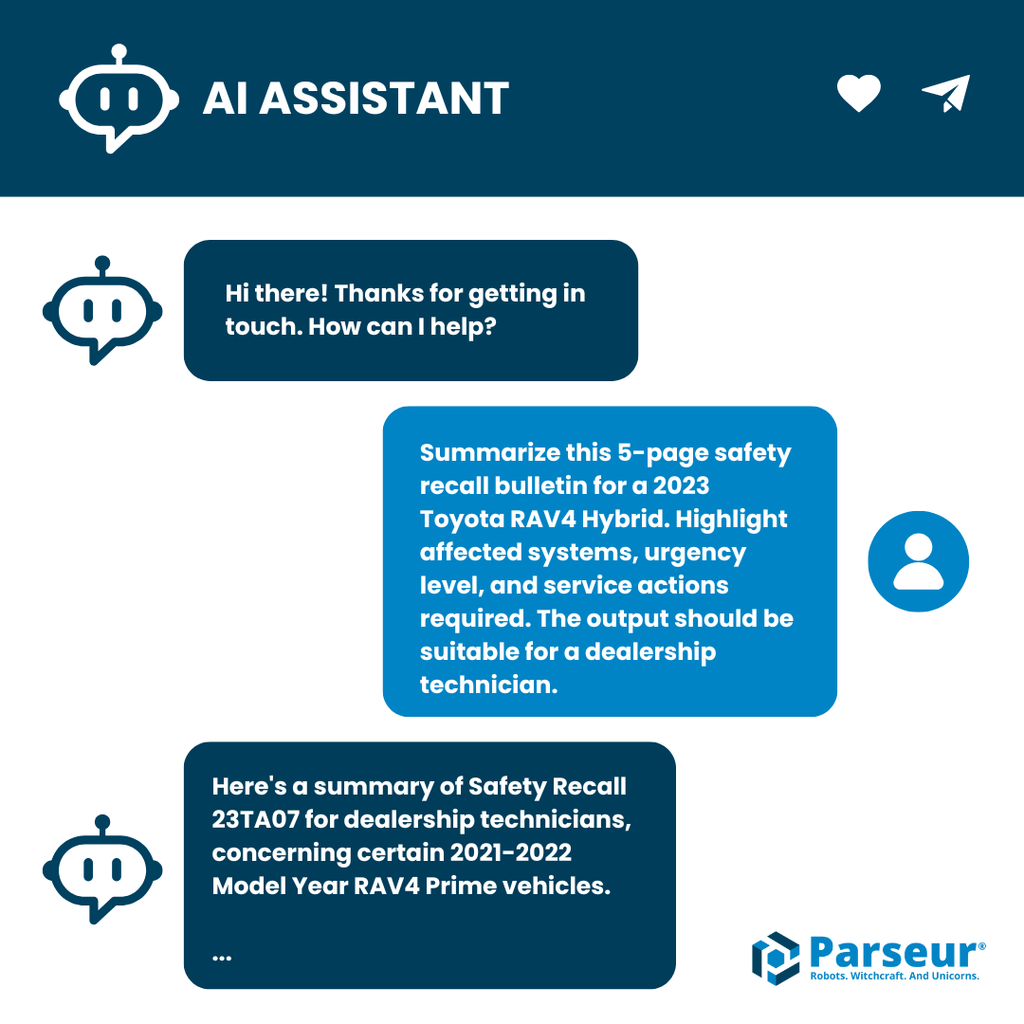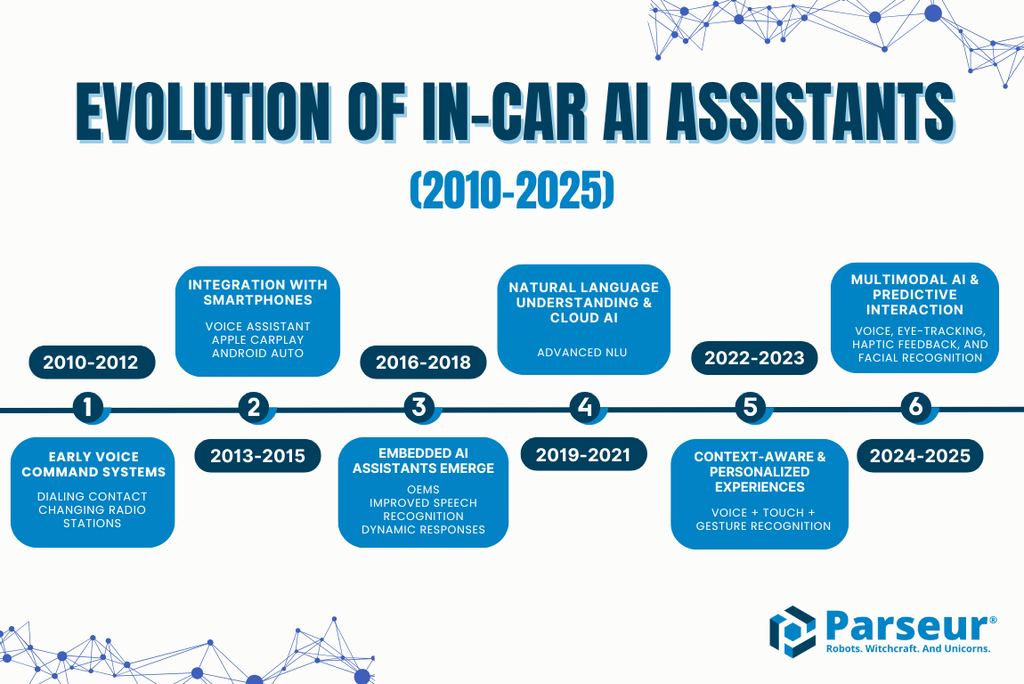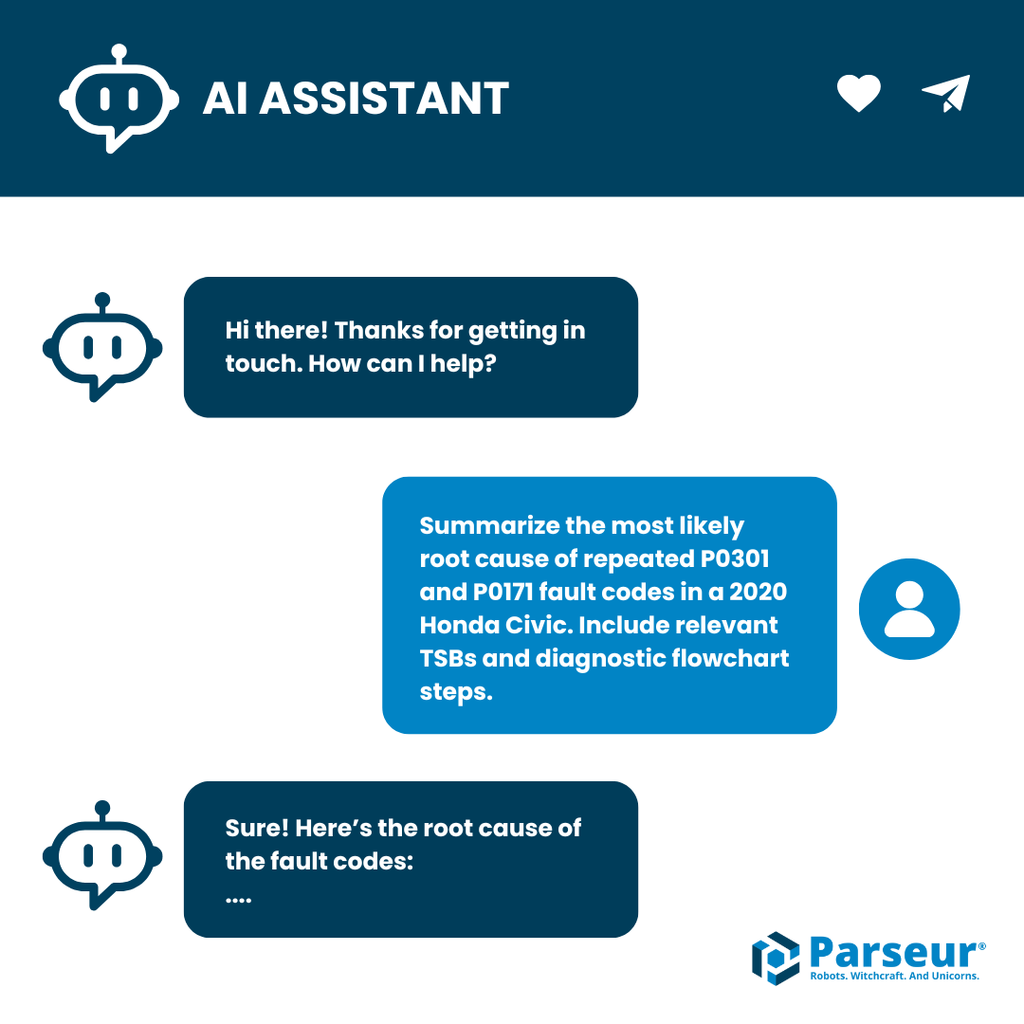Key Takeaways:
- AI is driving major transformation across the automotive industry, from maintenance to user experience.
- Intelligent Document Processing (IDP) reduces manual workload and speeds up data handling at scale.
- Generative AI enhances recall, diagnostics, and service documentation with real-time insights.
- Automated parsing improves supply chain agility and ensures faster, accurate regulatory compliance.
The automotive industry is undergoing a significant transformation as artificial intelligence (AI) becomes increasingly embedded across the entire value chain. From autonomous driving systems to predictive maintenance and customer experience, AI is no longer a futuristic concept, but a present-day force. Market US projects the AI automotive market will reach approximately USD 134.3 billion by 2033, a substantial increase from USD 7.7 billion in 2024, demonstrating a compound annual growth rate (CAGR) of 37.4% over the forecast period from 2025 to 2034.
Between 2024 and 2025, OEMs, dealer groups, and mobility tech firms are expected to accelerate AI investments, especially in intelligent data capture, automation, and advanced analytics, with over 80% of surveyed dealers planning AI investments to boost efficiency and profitability, according to Boston Consulting Group (BCG). As digital ecosystems within vehicles and supply chains expand, the need for fast, accurate, and scalable document processing is growing.
Manual methods can no longer keep up with the volume and velocity of information, such as expense receipts, warranty claims, vehicle inspection reports, insurance forms, and supplier invoices. This is where intelligent document processing (IDP) solutions, such as Parseur, play a pivotal role. They help automotive businesses extract structured insights from unstructured data, reduce operational overhead, and gain a competitive edge in a rapidly digitizing market.
How Automotive Leaders Are Adopting Intelligent Document Processing
According to a McKinsey global executives survey, nearly 70% of organizations are piloting or scaling automation initiatives like Intelligent Document Processing (IDP) to boost efficiency in document-heavy processes. Tier-1 suppliers focus on automating supplier invoices and logistics, while larger dealer groups use IDP to streamline service orders, warranty claims, and finance submissions, reducing delays and errors.
Real-world performance data further highlights the value of these efforts. According to Market US, Intelligent Document Processing (IDP) solutions typically deliver a 30% to 200% return on investment within the first year, driven largely by labor cost savings and efficiency gains. Implementations have also demonstrated up to 70% cost reductions, error rates lowered by more than 50%, and accuracy levels reaching 99% or higher, enabling significant productivity improvements across industries.
In the automotive context, faster invoice processing translates to improved supplier relationships, quicker parts invoicing, and enhanced cash flow management. Dealers using IDP to automate service billing and parts delivery documentation report measurable gains, shortening processing cycles from days to hours.
As data volumes continue to expand from connected vehicles generating inspection logs to digitized parts invoices and financing documentation, manual workflows are increasingly becoming bottlenecks. Intelligent document processing not only accelerates these processes but also improves accuracy and traceability. This is critical in an industry tied to compliance, warranty management, and regulatory reporting.
Visit the step-by-step guide, which covers practical strategies for launching and scaling document automation in automotive workflows.
How Generative AI Is Transforming Content Automation In The Automotive Industry
The rise of large language models (LLMs) and retrieval-augmented generation (RAG) pipelines is redefining how the automotive industry manages and extracts value from unstructured documents. From dense technical manuals to regulatory recall notices, these AI systems are helping OEMs (Original equipment manufacturers), suppliers, and service centers turn static information into dynamic, usable insights.
One of the most impactful applications is the automated summarization of repair manuals, which can often exceed 100 pages per model. Generative AI can now produce short, context-aware summaries tailored to the technician's role or the specific component involved, dramatically reducing the time spent searching for relevant information.
Another emerging use case is AI-driven recall notice triage. Traditionally, service centers rely on staff to manually read and interpret lengthy bulletins, increasing the risk of delays or miscommunication. With generative AI, service teams can now deploy agents that parse PDF bulletins, extract key instructions, and even auto-generate service alerts or customer notifications based on VIN or geography.
Thanks to RAG architecture, these systems generate content and ground responses in verified source documents. This is especially critical in automotive settings, where accuracy, regulatory compliance, and traceability are non-negotiable.

As LLM-powered systems mature, we expect to see broader use across warranty processing, regulatory reporting, and multilingual customer support, all areas traditionally hampered by time-consuming document reviews.
Generative AI is not just a content engine; it’s becoming an intelligent interface for every team that works with complex automotive documentation.
In-Car AI Assistants And Automotive UX Evolution
The cockpit of the modern vehicle is undergoing a transformation driven by artificial intelligence. They are evolving into sophisticated, multimodal agents that combine voice recognition, natural language understanding (NLU), and visual sensors to deliver a seamless driver experience.

Modern systems now incorporate real-time data pipelines, including JSON feeds with charging station availability, pricing, and personalized user preferences. These enable AI agents to respond with relevant and actionable insights. For example, a voice command like “Find the nearest available fast charger under $0.40/kWh” triggers a backend query that cross-references location, pricing, and charger type within seconds.
Beyond voice, the integration of cameras, eye tracking, and haptic feedback introduces multimodal interactions that elevate both safety and convenience. These systems adapt to driver behavior, adjust displays, and respond more intuitively to natural human input.
As in-car assistants become central to the driving experience, automotive brands are investing in UX frameworks that rely on rich, structured data and edge AI capabilities. This is setting a new benchmark for connected mobility.
AI-Powered Predictive Maintenance And Mechanic Augmentation In The Automotive Industry
As vehicles become increasingly connected, predictive maintenance is becoming a cornerstone of operational efficiency across the automotive industry. By harnessing parsed service logs, telematics, and sensor data, manufacturers and service centers can now anticipate component failures before they happen, reducing costs and improving safety.
Based on Data Insights Market, the global automotive predictive maintenance market is valued at approximately $2 billion currently in 2025 and is projected to grow at a 15% CAGR through 2033, reaching around $7 billion by then. These insights don’t come from raw data alone. Tools like Parseur automate the extraction of relevant information from OBD-II code tables, technician notes, and warranty claims. This structured data is then routed into analytics engines to flag at-risk vehicles based on historical failure patterns and real-time readings.
In parallel, AI-powered diagnostic assistants are augmenting mechanics in the garage. Large Language Models (LLMs) trained on thousands of repair manuals and fault code databases can provide quick insights, recommended fixes, or even voice-based support during inspection.
Prompt Example for a Diagnostic LLM Assistant

As predictive tools become more intelligent, workshops will transition from reactive repairs to continuous, proactive servicing, cutting costs for OEMs and boosting vehicle reliability for consumers.
How AI Is Revolutionizing Automotive Parts Analytics And Supply Chain Management
As automotive manufacturing grows more complex, the need for supply chains that are both resilient and responsive has never been greater. AI-powered document processing is playing a central role in transforming the way OEMs, suppliers, and dealers manage inventory, procurement, and logistics operations.
Approximately 78% of automotive manufacturers have implemented some form of AI in their operations, with many leveraging AI to optimize supply chains and reduce production disruptions by 47% compared to traditional methods, according to Syndell.
One of the most impactful applications is invoice-to-purchase-order (PO) matching. Traditionally, format mismatches, data entry errors, and, in 2026, inconsistent supplier documents contributed to high reconciliation overheads.
AI systems also facilitate real-time parsing of shipment manifests and delivery receipts. Once manually reviewed and cross-checked, these documents can now be processed instantly, triggering dynamic inventory reordering or routing adjustments when needed. As a result, organizations can adapt to changes in parts availability with greater agility.
Ultimately, these advancements signal a broader shift toward data-driven supply chain orchestration. By leveraging AI to extract structured insights from unstructured documents, automotive companies are better equipped to forecast demand, manage disruptions, and improve supplier collaboration, laying the groundwork for a more intelligent and resilient supply chain ecosystem.
How Automotive Companies Use AI For Regulatory Reporting, Safety Alerts, And Sustainability Goals
As regulations grow more complex and environmental targets tighten globally, automotive companies face mounting pressure to automate compliance documentation and improve safety and ESG (Environmental, Social, Governance) reporting. Manual processes can no longer keep pace with the volume and variability of data required to meet international standards.
Manufacturers and importers now rely on intelligent document processing (IDP) to extract emissions data across more than 50 global jurisdictions, accelerating submissions to regulatory bodies and reducing the risk of noncompliance.
The need for standardized documentation has grown substantially in the electric vehicle (EV) space. Government incentives like rebates, tax credits, and green-energy grants now require highly specific paperwork. AI-powered tools help auto brands generate and validate EV documentation templates that vary by region and program requirements.
On the safety front, AI systems are increasingly used to monitor regulatory bulletins and alert service networks to urgent recall notices and compliance deadlines. Rather than reading through dense technical PDFs manually, dealerships and fleet operators now deploy large language models (LLMs) to triage and summarize bulletins in real time, ensuring faster and more accurate responses to safety risks.
Together, these advances reduce administrative friction, improve regulatory agility, and support the automotive industry’s long-term shift toward greener and safer transportation.
Embracing The Future Of Automotive With AI
As the automotive industry navigates 2026 and beyond, six powerful trends are converging to reshape the way manufacturers, suppliers, and dealers operate. From the rise of generative AI and in-car assistants to predictive maintenance, smarter supply chains, and automated compliance workflows, one thing is clear: data is the fuel, and automation is the engine.
Across each trend, intelligent document processing (IDP) emerges as a foundational enabler, turning unstructured data into actionable insights at scale. Whether it’s parsing emissions reports, automating invoice matching, or powering LLM-based diagnostics, IDP technologies like Parseur are helping automotive leaders cut costs, increase accuracy, and accelerate innovation.
The strategic imperative is no longer just to digitize, it’s to automate intelligently.
Ready to automate your document workflows and take advantage of next-gen AI?
Last updated on




